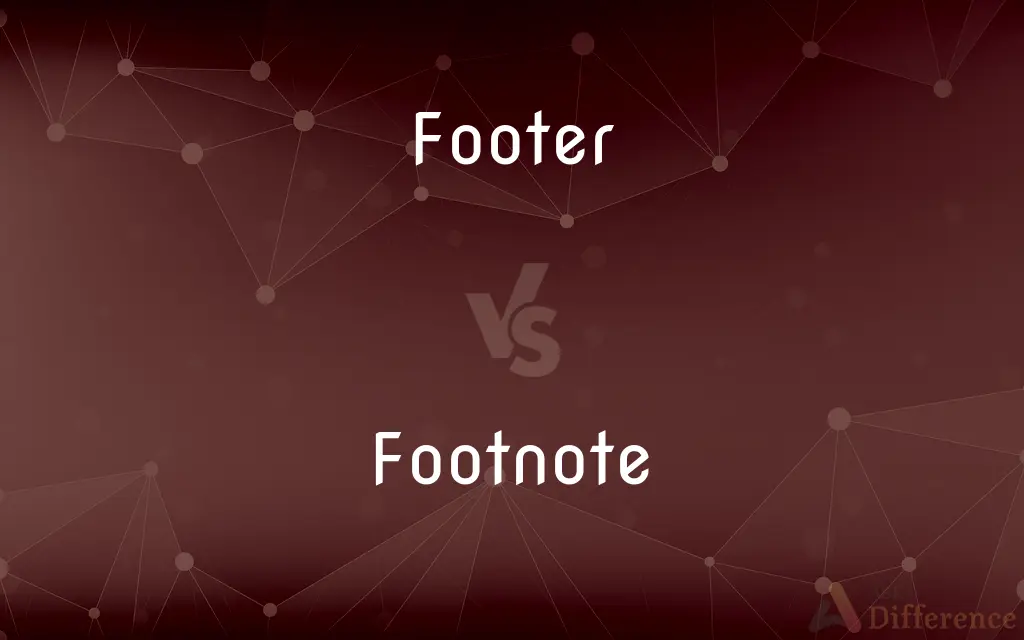Footer vs. Footnote — What's the Difference?
Edited by Tayyaba Rehman — By Maham Liaqat — Updated on March 15, 2024
A footer is a section at the bottom of a document page containing information like page numbers, whereas a footnote provides additional information or citations at the bottom of the page where referenced.

Difference Between Footer and Footnote
Table of Contents
ADVERTISEMENT
Key Differences
Footers are consistent elements found at the bottom of document pages, often including data such as page numbers, document title, or author's name. This consistency helps in navigating and identifying the document. On the other hand, footnotes are unique to specific pages, appearing only where an in-text reference requires further explanation or citation. They are crucial for providing detailed information without cluttering the main text.
While footers serve a more functional role in document layout, aiding in orientation and providing essential information at a glance, footnotes play a critical academic role. They allow authors to cite sources or offer additional insights, ensuring the integrity and depth of the document's content. This difference underscores the footer's role in document structure against the footnote's in content enrichment.
Footers are often designed to be unobtrusive and consistent across a document or even a series of documents, maintaining a uniform appearance. In contrast, the content of footnotes can vary greatly from one page to another, depending on the references and additional information relevant to the text on that particular page.
In terms of interaction, footers may rarely change the reader's engagement with the document, providing a stable reference point. Whereas footnotes, by offering supplementary information or citations, invite the reader to delve deeper into the subject matter, potentially enhancing their understanding or leading them to further research.
Despite their differences, both footers and footnotes are essential for effective document design, contributing to the document's functionality and the richness of its content. They complement each other by separately addressing the needs for structural consistency and detailed academic substantiation.
ADVERTISEMENT
Comparison Chart
Location
Bottom of every page
Bottom of the specific page where referenced
Content
Typically includes page numbers, document title, author's name
Provides additional information, explanations, or citations
Consistency
Consistent across a document or series of documents
Varies based on the content of each page
Purpose
Aids in navigation and document identification
Enhances understanding by offering more details or citing sources
Interaction with Text
Minimal direct interaction with the main text
Directly linked to specific parts of the main text for elaboration or citation
Compare with Definitions
Footer
A section at the bottom of a page displaying consistent information.
The document's title was included in the footer for easy identification.
Footnote
Provides extra information or clarification.
The footnote elaborated on the historical context mentioned in the text.
Footer
Contains page numbers for easy navigation through documents.
She quickly found the section by referring to the page numbers in the footer.
Footnote
May offer translations of foreign terms or phrases.
The footnote provided an English translation of the French phrase used in the text.
Footer
May include the author's name for document attribution.
The footer contained the author's name, ensuring proper attribution.
Footnote
Can contain cross-references to other parts of the document.
A footnote directed readers to a related discussion in a different chapter.
Footer
Sometimes used for copyright notices.
Copyright information was discreetly placed in the footer.
Footnote
Used for citations and referencing sources.
She cited the source in a footnote to credit the original author.
Footer
Can be used to display the document's publication date.
The publication date in the footer helped in identifying the document's currency.
Footnote
Sometimes includes comments or insights from the author.
The author added a personal anecdote as a footnote, adding depth to the narrative.
Footer
One that is an indicated number of feet in height or length. Often used in combination
A six-footer.
Footnote
A note placed at the bottom of a page of a book or manuscript that comments on or cites a reference for a designated part of the text.
Footer
Textual information, such as a title, date, or page number, positioned in the bottom margin of a page and usually repeated throughout a document.
Footnote
Something related to but of lesser importance than a larger work or occurrence
A political scandal that was but a footnote to modern history.
Footer
See footing.
Footnote
To furnish with or comment on in footnotes.
Footer
(archaic) A footgoer; pedestrian
Footnote
A short piece of text, often numbered, placed at the bottom of a printed page, that adds a comment, citation, reference etc, to a designated part of the main text.
Consult the footnotes for more details
Footer
(computing) A line of information printed at the bottom of a page to identify the contents. (Compare foot in printing.)
Footnote
(by extension) An event of lesser importance than some larger event to which it is related.
A mere footnote in history
Footer
(in combination) Something that measures a stated number of feet in some dimension.
The new boat is a six-footer.
Footnote
A qualification to the import of something.
Footer
(in combination) Someone who has a preference for using a certain foot.
A right-footer
Footnote
To add footnotes to a text.
Footer
Football / soccer.
Footnote
A note of reference or comment at the foot{4} of a page.
Footer
To meddle with or pass time without accomplishing anything meaningful.
Footnote
A printed note placed below the text on a printed page
Footer
A person who travels by foot.
Footnote
Add explanatory notes to or supply with critical comments;
The scholar annotated the early edition of a famous novel
Footer
(used only in combinations) the height or length of something in feet;
He is a six-footer
The golfer sank a 40-footer
His yacht is a 60-footer
Footer
A person who travels by foot
Footer
A printed note placed below the text on a printed page
Common Curiosities
How does a footer differ from a footnote in terms of content?
A footer contains consistent information across pages for navigation or identification, while a footnote provides detailed explanations or citations specific to the page content.
Can footnotes and footers appear on the same page?
Yes, both footnotes and footers can appear on the same page, with footnotes providing additional information and footers offering consistent page-related details.
What is a footnote?
A footnote is a note at the bottom of a page in a document, providing additional information, explanations, or citations related to the text referenced by superscript numbers or symbols.
Are footnotes only used for citations?
While commonly used for citations, footnotes can also provide additional explanations, translations, or any relevant information that supplements the main text.
What is a footer in a document?
A footer is a consistent section at the bottom of document pages, often containing information like page numbers, the document title, or the author's name.
How do footnotes enhance a document?
Footnotes enhance a document by offering further explanations, insights, or citations, enriching the content without cluttering the main text.
What kind of information is typically found in a footer?
Information such as page numbers, document title, author's name, and publication date are typically found in footers.
Can footnotes include personal comments from the author?
Yes, authors may include personal comments or insights in footnotes to add perspective or share experiences related to the document's content.
Are footers always present on every page of a document?
While commonly found on every page, footers may sometimes be omitted on specific pages like the title page or sections where design considerations take precedence.
Why are footers important in documents?
Footers help in easy navigation through documents and provide important information at a glance, like page numbers or document titles.
Do all documents have footers?
Not all documents have footers; their inclusion depends on the document's format, design, and the author's or publisher's preferences.
Can a footnote contain a citation?
Yes, footnotes are often used to cite sources, providing a way to credit original authors and support the document's content with authoritative references.
Is there a limit to how much information can be included in a footer?
While there's no strict limit, footers are generally kept concise to avoid distracting from the main content of the document.
How do footnotes contribute to academic writing?
Footnotes are crucial in academic writing for citing sources, offering additional analyses, and providing clarifications, which contribute to the credibility and depth of the work.
How do readers benefit from footers and footnotes?
Readers benefit from footers by easily navigating and identifying document information, and from footnotes by gaining deeper insights and access to cited sources for further exploration.
Share Your Discovery

Previous Comparison
Interchangeable vs. Exchangeable
Next Comparison
Cycle vs. PatternAuthor Spotlight
Written by
Maham LiaqatEdited by
Tayyaba RehmanTayyaba Rehman is a distinguished writer, currently serving as a primary contributor to askdifference.com. As a researcher in semantics and etymology, Tayyaba's passion for the complexity of languages and their distinctions has found a perfect home on the platform. Tayyaba delves into the intricacies of language, distinguishing between commonly confused words and phrases, thereby providing clarity for readers worldwide.














































